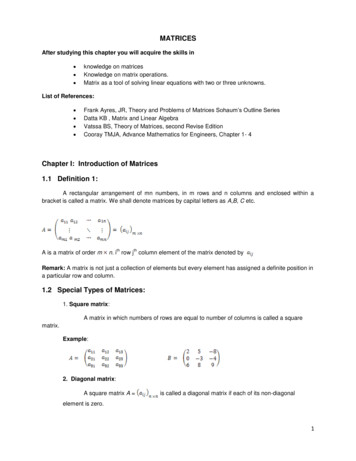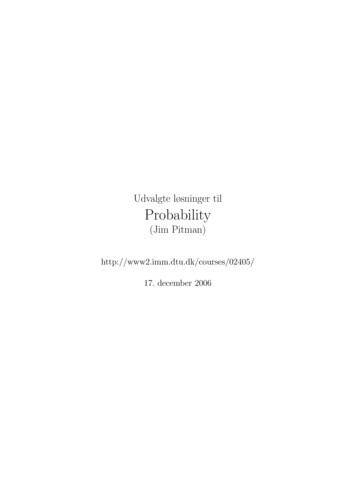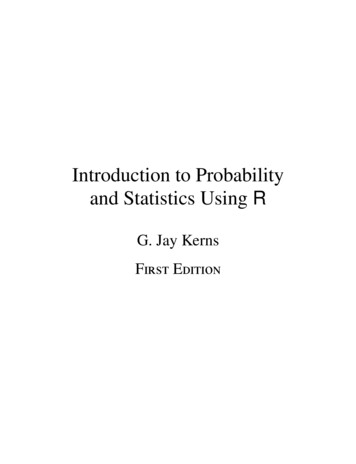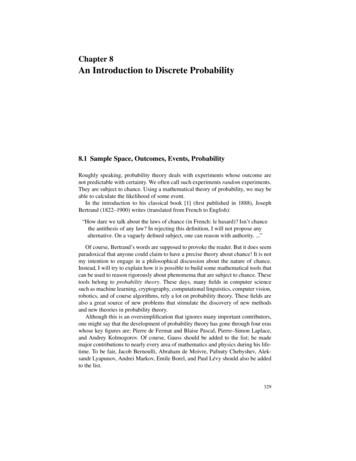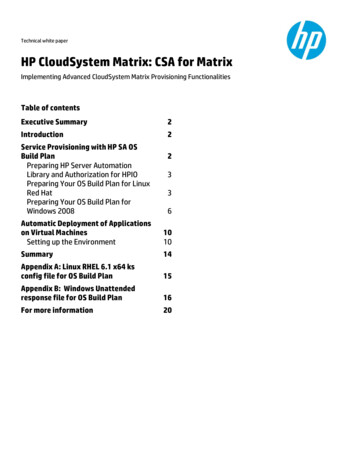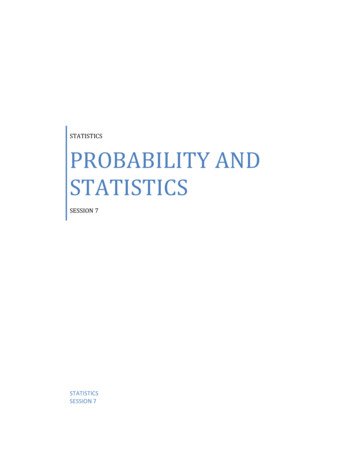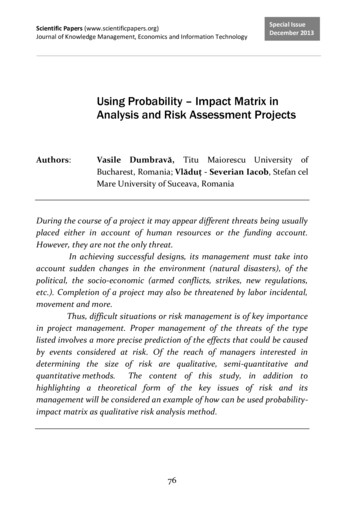
Transcription
Scientific Papers (www.scientificpapers.org)Journal of Knowledge Management, Economics and Information TechnologySpecial IssueDecember 2013Using Probability – Impact Matrix inAnalysis and Risk Assessment ProjectsAuthors:Vasile Dumbravă, Titu Maiorescu University ofBucharest, Romania; Vlăduț - Severian Iacob, Stefan celMare University of Suceava, RomaniaDuring the course of a project it may appear different threats being usuallyplaced either in account of human resources or the funding account.However, they are not the only threat.In achieving successful designs, its management must take intoaccount sudden changes in the environment (natural disasters), of thepolitical, the socio-economic (armed conflicts, strikes, new regulations,etc.). Completion of a project may also be threatened by labor incidental,movement and more.Thus, difficult situations or risk management is of key importancein project management. Proper management of the threats of the typelisted involves a more precise prediction of the effects that could be causedby events considered at risk. Of the reach of managers interested indetermining the size of risk are qualitative, semi-quantitative andquantitative methods. The content of this study, in addition tohighlighting a theoretical form of the key issues of risk and itsmanagement will be considered an example of how can be used probabilityimpact matrix as qualitative risk analysis method.76
Using Probability – Impact Matrix in Analysis and Risk Assessment ProjectsSpecial IssueDecember 2013Keywords: management; probability; analysis; riskIntroductionPerformed by individuals any activity that is registered as risky involvesincidents or accidents generating damages, especially economic.Sometimes the manifestation of these incidents can cause loss of humanlives. Therefore, institutions, companies, and projects are permanentconcern of the persons appointed mandatory to identify potentialactivities that could be characterized as threats or risks in achievingobjectives. Avoiding the generation of hazardous events is possible if theprojects are thoroughly analyzed and properly assessed, and, of course,corrected at time. Thus it is switched from a higher or high-risk on aacceptable lower level. If it is considered this period affected by theeconomic crisis, the approach of the policy makers of the potential risksof projects in a serious and pragmatic manner this shall mean aguarantee that the project has increased chances of completion.The increasingly importance of risk management made possibleits emergence and development, especially in the countries withfunctioning financial markets. In Romania this subject is just beginningto be taken into account, there are few "organizations with their ownmechanisms for measuring and risk coverage, others do not know theadvantages that you would get by applying the procedures alreadyestablished" (ANCS, 2010). Adopting the principles of this branch ofmanagement by an ever increasing number of economic entitiesincreased in our country is mainly related to the need for safety in allactivities. It is no less important the trend in this direction registered atEuropean Union level. Put pressure towards the analysis and riskassessment the preparation of draft requesting the EU funding can alsobe a good support in faster acceptance for risk management and itsmethods.77
Using Probability – Impact Matrix in Analysis and Risk Assessment ProjectsSpecial IssueDecember 2013Specific to the assessment of event risk is a two-dimensional approach:on the one hand, from the point of view of the uncertainty occurrence(probability) and the other hand from the viewpoint of the outcomeeffect (impact). Quantification is possible using quantitative, qualitativeand semi quantitative methods. When assessing major risks "isrecommended quantitative evaluation methods that provide an accurateestimate of the possible consequences" (Iacob, 2013). The result based ona quantitative analysis may lead the decision makers to establish specificmeasures in order to ensure better protection for the potential receptorsof risky events. For risk categories with lower impact quality assessmentmethods are preferred, which, even if they are slightly biased, give tointerested parties a suggestive image of the size of the risk analysis. Thismaterial was conceived in order to present the main concepts relatedprojects, risk and its management in projects and examples of riskassessment using qualitative methods: probability-impact matrix.Risk within ProjectsThe projectThe aim of human activity is to meet the various needs of getting a result,to complete a certain job, etc. Thus achieving a goal or set of goals couldbe recorded as a realization of a "project". Following this argument wecan say that most of the things around us are the result of projects, thethinking of designers and effort of individuals or groups of individuals toput them into practice. If reference is made to the "the world wonders",taking into account their age could appreciate that the projects exist formillennia. However, in today's sense, the concept of design is relativelyyoung.In recent decades the term "project" has been defined by manyexperts (Rutman and Mowbray, 1983; Conrad and Hedin, 1987; Hayes,1989; Valadez and Bamberger, 1991; Munns and Bjeirmi, 1996; Măţăuan,1999). The last years of the millennium bring to the fore a new generation78
Using Probability – Impact Matrix in Analysis and Risk Assessment ProjectsSpecial IssueDecember 2013of authors (Lewis, 2000; Ciobanu, 2002; Turner and Simister, 2004;Bоrgăoanu, 2005; Bulat, 2011; Opran, et al., 2012) retaining and enrichedthe definitions of their predecessors. In this way the project is a set of"specific elements: objective data specifically allocated resources,planned activities dedicated team fixed" (Pascu, 2005). Following theEuropean Commission (1986), the project is defined as a "group ofactivities to be performed in a logical sequence to achieve a set ofpredetermined objectives formulated by the client" (Istrate, 2004).Subsequent appreciations designate the project as "an action that has abeginning and an end and is undertaken in order to achieve theobjective, in compliance costs, calendar and plan quality criteria" (Hayes,1989). In a recent definition with no significant differences, the project is"a set of actions performed over a period of time, with moments definedstart and end with a clear purpose of the work performed by a ownbudget and a specified level of results achieved." (Lewis, 2000).Consequently, "the projects share a number of elements: a uniquepurpose, for a period of time for completion (with start and end time),consumption of material, financial, human” (Iacob 2013).The many and diverse needs are found in the multitude andvariety of projects. The new way to do something is the project. Projectsfever swept across the world. There are projects on all continents in alleconomic and noneconomic sectors, for all sorts of ideas. In Romania thenew fashion spread in all areas "mingling with the need to obtain projectgrants" (Negoiescu, 2003). The existence of different types of funds madeavailable by the European Union for development seems to be"enlightened" guidelines for resolving diverse needs of businesses,institutions or other organizations. Romanian projects try to give a freshface and impose a new pace in industry, agriculture, tourism, music,health, administration, etc. They are not a whim to be fashionable butalso are a necessity. Without the project it cannot be capitalize anybusiness idea cannot get money for the programs financed by the Union.Also, it should be noted that a draft drawn up improperly is ineligible tofinance. The solution to a draft document, well written may be working79
Using Probability – Impact Matrix in Analysis and Risk Assessment ProjectsSpecial IssueDecember 2013with people specialized in this direction. These specialists will be able toovercome the oppressive realities facing many projects: insufficientdocumentation, conflicts within teams, failure to comply with deadlinesand budget, work unreasonable (in advance or additional) low aftercompletion functionality poor, budget and time inconsistency,inadequate employment, insufficient documentation etc.The project, as a whole assigned action in a particular temporaland spatial context in which allocations occur, should produce changesfor the better. In any project allocation the decisions taken by themanager must take into account the purpose, time, and cost (Figure 1).These are the constraints of "the iron triangle" (Weaver, 2007; Lock, 2010)Figure 1: The Project Management TriangleEven if the project manager seems "trapped" in these constraints,he can maintain the quality of the project, if he has skill and sufficientlyopenness to manage a "a flexible triangle" (Ambysoft, 2012), in which atleast one point varies.Project managementProper operation of the project processes is observed by the projectmanager. He does not do this by himself but helped by a team. The team80
Using Probability – Impact Matrix in Analysis and Risk Assessment ProjectsSpecial IssueDecember 2013can be smaller or greater depending on size of the project. Within theteam the decisions are taken for allocating available resources,identifying and analyzing potential risks, there are outlined possiblemeasures, responsibilities and tasks to be assigned for each person. Thesuccess of the project depends on how the team assumes the projectobjectives. Project goals "provide a starting point for decision making andnot a hard set of rules that the project team must work" (Coates, Koyland Langford, 2008). When designing the project, it is preferable thatthese objectives to be chosen based on SMART criteria (Specific,Measurable, Achievable, Relevant, Time-based). A good managementshould pursue profitability of the project, to take into account thecompetitionto lead to the "satisfaction of the beneficiaries and thirdparties" (Kerzner, 2003). As the "ingredients" of success should not beomitted: organizational resilience, executive commitment, ensuringplanning and control, leadership of the project manager (Javed, 2009). Inessence, project management is a methodical approach for themanagement and coordination of the processes within a project fromstart to finish or a "set of activities for achieving a successful group ofobjects. This includes planning, programming and support for theconduct of project activities "(WOD, 2010).The notion of risk associated with projectsComplex structural relationships in the current social and economicsystem change with the development of science. Any progress isaccompanied by tensions that could lead to risks. The theoretical andpractical aspects of the concept are treated differently depending on thelevel where there is the possibility of the event risk: at the individual level - insurance, pensions, personalinvestments, health, etc. at the level of project - strategy, plans, management etc at the level of business - business strategy, corporate governance,etc.81
Using Probability – Impact Matrix in Analysis and Risk Assessment ProjectsSpecial IssueDecember 2013 at the society level - food security, economic performance,terrorism etc.Hillsong and Webster (2004) argue that although the term risk iscommon to both areas, in theory and practice there is not yet aconsensus interpretation. However various professional organizationsand national and international standards (AS/NZS4360 1999 ProjectManagement Institute 2000 British Standards Institute 2000 Institutionof Civil Engineers 2002) addresses in a scientific manner, the risk gettingcloser to a comprehensive clarification of this concepts.The existence of different views does not preclude acceptance ofrisk as a result of its two dimensions: the likelihood and impact (Hillsonand Hulett 2004; Mitruţ, 2005). Likelihood is derived from uncertainty ofrisk occurrence. The impact is the effect of the contingency. Potentialevent of loss designating risk (R) is translated in mathematical terms as aresult of the product of the size of the impact (I) and likelihood of (P).R IxP(1)Risk costs. It may affect the integrity of the environment,property and individual being perceived as "potential harm" (Mitruţ,2005). For this reason, stakeholders want to know "risk event effects(results), their chances of occurrence (probability) and the severity orimpact on the affected perimeter" (Druică, 2011). Any risk manager knowsthat the risk-within the projects can be caused by tolerating deviationsfrom the planned initiative. An eventual materialization of the riskrequires taking responsibility. Avoiding the development of pressureswithin the project and to third parties relating to the various effects ofrisk is possible by designing, developing and presenting a risk plan by theproject manager. This document will allow the identification,formulation, calculation, preparation of response measures, monitoringand control of project risks.82
Using Probability – Impact Matrix in Analysis and Risk Assessment ProjectsSpecial IssueDecember 2013Risk Management within the ProjectsThrough appropriation of being unique in its own way, any project canface specific risks previously inexperienced. If one of uncertain eventsoccurs, the project objectives may be affected. The first step in riskmanagement is the recognition of a potential risk. Project managementtask is to seek solutions to avoid risky situations. Hillson and Hulett(2004) points out that "there is no collection of lessons" learned from thevarious projects that provide the solution to overcome certain types ofrisks. Otherwise, to resolve difficult situations, each project manager,based on experience and by virtue of the similarity of the situationspreviously faced must challenge the project he leads. Going through allthe stages and phases of its life cycle it is essential to complete theproject. The project team will consider the objectives (to budget,achievement of milestones, compliance deadlines, insurance andresource consumption, etc.) and avoiding risks. Inadequate coordinationof team, undocumented and hasty actions, failure planning can makedifficult situations even stated objectives at risk. An effective way tomanage critical situations and adopt the best measures of positiveconsequences, thus minimizing the risk materializes, is to to giveimportance to proper risk management. From the literature (AS / NZS4360:2001, Fraser and Cooper, 2005; Mironescu, 2005) it is drawn theconclusion that the application of risk management in projects involvesthe following steps: establishing the context in which risk occurs, it’scorrect identification, risk analysis, risk assessment, risk control,Figure 2.In the risk management process each stage has its importance.First stage. Determine the context of management, organizational andstrategic establishing the composition and risk assessment procedures.Also here will be given precise ways of consultation and communicationwith stakeholders or affected.83
Using Probability – Impact Matrix in Analysis and Risk Assessment ProjectsSpecial IssueDecember 2013Figure 2: Risk management stagesThe second stage. It is by far one of the most important steps inproject risk management. Here risks configuration occurs associated withthe identification of hazards and consequences. It's where riskmanagement occurs. One cannot think anything related to a particularrisk and is not useful to make action plans if that risk status does notbelong to the context. Risk identification begins where the problemcomes. It is necessary to study the basic organizational goals, the similarrisk scenarios if any. As a result of these analyzes may create a risk map.Road to the success of the project is provided through the permanent riskof this map.Identification of risk in projects or organizations with a holistic approachis not suitable. Such treatment is counterproductive and does notstimulate creative thinking team. Moreover, in order to correctly identify84
Using Probability – Impact Matrix in Analysis and Risk Assessment ProjectsSpecial IssueDecember 2013potential risks, decision makers should pay equal attention to everysignificant aspect of the project. Thus, about the technical side of theproject, possible risks such as misunderstanding of drawings, degree ofdifficulty in assembling two components, improper use of newtechnologies, etc. Regarding project management can identify risks ofmisallocation of human resources, indiscipline etc., It can also beidentified organizational risks, eg conflicts on access to, resources,funding interruptions, non-succession of works, project no longerwanted etc. Besides these, there might be external risks, other thanthose forming part of the force majeure, eg adverse weather conditions,as country risk, changes in legislation, changes in market outlets etc.Third stage. Risk analyse. The third step involves qualitative andquantitative risk analysis, establishing opportunities for control andeffect of control measures regarding the consequences and estimatingthe probability of risk. There will also be assessed frequency and severityof risk.In the evaluation of the risks, costs and benefits are estimatedactivity being communicated to stakeholders. Evaluation criteria shouldbe concise and for the efficiency of the measurements must be small. Inthe assessment must be captured all sides of activity. risk probability (almost certain / likely / likely / likely / rare) the level of risk (extreme / high / moderate / low / negligible) consequent (catastrophic / high / moderate / low / insignificant).If the risk occurs, its treatment is to identify the measures thatshould be taken. Development of mitigation measures is to respond tothreats and to introduce corrections. Applicable solutions should beobtained by methods known to be well founded. They should giveconfidence that there are no other risks after application. Risk treatmentinvolves drawing up a plan that targeted risk mitigation procedurespredefine This plan is part of the risk management plan.The last stage of the risk management process is risk monitoringentails: check the validity of the assumptions on the risks identified85
Using Probability – Impact Matrix in Analysis and Risk Assessment Projects Special IssueDecember 2013is intended that the measures at risk are implemented asplannedthere is response measures to correct the effects ofimplementation risksidentify possible new risks either seek symptoms of known risksdevelopment seeks exposureProbability Impact Matrix, Qualitative Method forAssessing the RiskGeneralities regarding risk assessment methodsEffective management of a project is not only to identify what types ofrisk can influence completion. In today's economic climate, more thanthe increasingly, decision makers need calculations and results that givea level of magnitude of risk analyzed, based on which to assess theconsequences that may result from its influence. As they madeclarifications in text, risk assessment methods are quantitative, semiquantitative and qualitative.Quantitative and semi-quantitative analyses are performed usingstatistical methods (Monte Carlo, PERT, MCA, etc.) and include the useof quantitative or numerical data. Their result is quantitative. Thisapproach is more objective and accurate. For the results to be morerelevant it is necessary to use the correct input parameters from validsources. In the case of the quantitative results of risk analyzes "shouldnot be regarded as an exact numbers, but estimates of a variable thatdepends on the quality scale data" (Török, 2010).The qualitative assessments have usually descriptive results anddo not imply an accurate determination of risk. They provide support forfurther quantitative investigation. Successful achievement of a qualitativeassessment starts from the module documentation and data collectionintended for processing. Although they are considered formal,86
Using Probability – Impact Matrix in Analysis and Risk Assessment ProjectsSpecial IssueDecember 2013quantitative assessments of quality are preferred for several reasons asfollows: appears to be more easily understood by policy makers andothers; gives the perception of ease and rapidity in achievement; No quantitative assessment is required or insufficient data forsuch evaluation; No qualified staff for the use of quantitative evaluation methods.Even though sometimes such an assessment is not done quicklyor simply numeric data would be preferable to formal ones, the decisionmakers satisfy their need for information on the results of qualitativeassessments. In order to ensure continuity in the determination of anevaluation result to the methods apply the same principles as the unit ofdata collection. Depending on how the suggestion is appreciated riskprofile assessed by qualitative methods, improving information can bedecided by a quantitative assessment. That does not mean that theresults of qualitative investigations do not provide enough information.Conversely, qualitative risk assessment can capture previouslyunidentified prospects.It is recommended that the conduct of quantitative assessmentsto be followed and qualitative assessments because it can be identifiedthe likely magnitude of associated risks, uncertainties on the datacurrently available, etc. The conclusion is that much of the work for aquantitative assessment is made when it was made a qualitative riskassessment.Probability Impact MatrixProbability impact matrix is one of the commonly used qualitativemethods for risk assessment. The two components of risk (equation 1) areactually variable of such matrix. Risk calculation is very simpleconsidering that likelihood and impact of an event is assigned a randombasis to the total which can be a particular classification, Table 1.87
Using Probability – Impact Matrix in Analysis and Risk Assessment ProjectsSpecial IssueDecember 2013Table 1: Simplified model of the probability and impact 21Source: ownAfter awarding of the total (scores) for likelihood and impact ofrisk categories identified by the risk manager or project team memberswill proceed to multiplying the two variables. The result of this operationwill expunge degree of risk.This method was used in the project "Seminar: Trends in therestructuring and modernization of agriculture in the area of the LocalAction Group (LAG) Mountain Valley 2013" to form an image on the riskof not having the audience on scheduled courses.The first step was to define the probability of risk occurrence:Table 2: Likelihood score riskLikelihood levelScoreVery low0-20Low21-40Medium41-60High61-80Very high81-100The the second step was to set the impact on a scale of 1 to 5:88
Special IssueDecember 2013Using Probability – Impact Matrix in Analysis and Risk Assessment ProjectsTable 3: Impact AnalysisMagnitude ofimpactHigh impact/High probabilityImpact definitionVery highThey are the biggest risks thatentrepreneursshouldpayattention.High impact /MediumprobabilityMedium impact /High probabilityMedium impact /MediumprobabilityHighThese risks have either a highprobability of occurrence, or asignificant impactMedium impact /Low probabilityLow impact /MediumprobabilityLow impact /Low probabilityLowThese risks can occur in somesituations and have a low tomedium impact.MediumThere is a medium chance thatthe risks appear noticeableimpact.InsignificantThere are risks with lowprobability of occurrence andlow impact. Can therefore beneglected.ScoreRating5A4B3C2D1EThe the third step was to determine the risk exposure resultingvalues in Table 3.89
Special IssueDecember 2013Using Probability – Impact Matrix in Analysis and Risk Assessment ProjectsTable 4: Calculation of the exposure nablenumberFull houseVery low20LowMore thanplacesProbabilityDegree ofriskexposure h80Low2BVeryhigh100Very low1AScore12,52231,54150,5For the last step was built a risk matrix as shown in Figure 3.LIKELIHOODIMPACTLowMediumLow(unlikelyto occur)Medium(mayoccur at atime)High(likely tooccur)High(insignificant,just note)(reasonableimpact, to bemonitored)(will have asignificantimpact)EDCDCBCBAFigure 3: Probability impact Matrix90
Using Probability – Impact Matrix in Analysis and Risk Assessment ProjectsSpecial IssueDecember 2013The analysis matrix shows that the risk of not having learners formaximum fear is a risk class C, so a medium risk.ConclusionsThrough this study we made a short presentation of the concepts of riskand risk management projects. The whole text brings the readerstructured information, consistent, and well documented. Also, thecontents of the study were identified and information on the project andhow they are managed under the pressure of "the triple constraints" time- cost objectives, noted for as the "the iron triangle."Risk management process is a cautious attitude related to thepossibility of a risk materializing. Reducing or eliminating the damagethat could be caused by the manifestation of that risk lies in constructivedecision can be taken based on precisely this attitude. Risk managementof a project is subjected can be done only in terms of understanding risk,which is in fact, the general purpose of risk management.Risk identification and establishment of sizes for these additionalactions may sometimes be known as risk assessment or risk analysis. Inpractice, the most common method is to identify risk checklist(checklist). It is based on the idea that performs a process according to agiven standard. The differences from the actual implementation may ormay not score in the normal range by the risk manager. This method isnot sufficient in assessing complex risk which is why qualitative, semiquantitative and quantitative methods may be used.To obtain information relative safety in a descriptive way aboutrisks, managers appeal to qualitative evaluation methods that areapproved and that can be more easily explained to third parties. Thestudy concludes with a practical example using the probability - impactMatrix whose purpose is to calculate and determine the exposure in caseof an event considered to be at risk. The graphical presentation ofprobability - impact Matrix was pursued and highlight for the ease ofposition on a certain level of risk taken in the study.91
Using Probability – Impact Matrix in Analysis and Risk Assessment ProjectsSpecial IssueDecember 2013References[1] Bulat V., Cum scriu un proiect? Ghid de reguli de bază locale.md/download.php?file, accessedSeptember 15, 2013.[2] Bоrgăoanu, A., Managementul Proiectelor, ed.Economica ,Bucureşti, 2005[3] Ciobanu, R.M., Managementul proiectelor, Ed. Gh. Asachi,Iaşi, 2002.[4] Coates R., Koyl M, and Langford J., Allocating risk amongpublic and private partners, Optimum online, The journal /print.phtml?e mesokurj&id 318,[5] Conrad, D., Hedin, D., Youth Service: A Guidebook forDeveloping and Operating Effective Programs. Washington,DC: publisher Independent Sector, 1987.[6] Druică, E., Economia și managementul riscului, București,2011 www.unibuc.ro/./druica./2011aprEconomia riscului suport de curs, accessed September 15, 2013[7] Fraser D,. Cooper, B J., "Risk management: developing aframework for a water authority", Management ofEnvironmental Quality: An International Journal, Vol. 16 Iss:3, 2005.[8] Hayes, E.M., Project Management, CRISP, California,Publication, Inc., 1989.[9] Hillson, D. A., Hulett D. T., Assessing Risk Probability:Alternative Approaches, PMI Global Congress Proceedings .com/pdf-files/hha0404.pdf, accessed October 15, 2013.[10] Hillson, D. A., Webster R. M., Understanding and managingrisk attitude, 200492
Using Probability – Impact Matrix in Analysis and Risk Assessment ProjectsSpecial IssueDecember 2013[11] Iacob, V.S., Risk management and evaluation and qualitativemethod within the projects,International economicConference, 11th edition - Vision and Foresight in EconomicPolicies in Times of Crisis, Stefan cel Mare University ofSuceava, 2013[12] Istrate, I. and all, Comunităţi în mişcare: Programe şiintervenţii sociale. Bucureşti, Editura Agata,2004.[13] Javid A.S., Project manager skills necessary for tspapers/CEM520TermpaperPresentattionJavid.pdf[14] Kerzner, H., Project Management: A Systems Approach toPlanning, Scheduling, and Controlling, 2003, Available ptember 20, 2013[15] Lewis, J. P., The Project Manager's Desk Reference, McGrawHill, New York, 2000[16] Lock, D., Managementul Proiectului, ed. Monitorul Oficial,București, 2010.[17] Măţăuan, G., Evaluarea programelor sociale, Editura Expert,sub egida FIMAN, 1999.[18] Mironescu, R., Managementul riscului în proiectele finanłateprin programe europene, in Annals of University of lume/2005/management-si marketing/19.pdf[19] Mitruț, C., Managementul Riscului, Note de curs, ASE,București, l/carte1.asp?titlu S, accessed October 15, 2013.93
Using Probability – Impact Matrix in Analysis and Risk Assessment ProjectsSpecial IssueDecember 2013[20] Munns A. K., Bjeirmi B.F., The role of project management inachieving project success” International Journal of ProjectManagement, Elsevier Science, Vol. 14, No. 2, 0263-7863/96,1996, Available at:https://notendur.hi.is/vio1/The role of project management in achieving project success.pdf
Analysis and Risk Assessment Projects Authors: Vasile Dumbravă, Titu Maiorescu University of Bucharest, Romania; Vlăduț - Severian Iacob, Stefan cel Mare University of Suceava, Romania During the course of a project it may appear different threats being usually placed either in account of human resources or the funding account.

